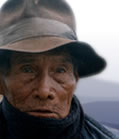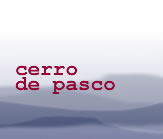Ignacio is a farmer and has worked in different jobs in the mines. He is member of the Paccha campesino community through his mother. He now works her farm and his own. He has a wife from San Pedro de Cajas, and another companion from Paccha with whom he has three children.
He describes the impact of pollution from the foundry in the town, on people's health and his own physical reaction. He describes the poor early working conditions. He details the impact of pollution on the farm - on the plants and the animals and the different diseases caused by pollution. The community eats contaminated animals as they think they're harmless if well cooked.
He has periodically taken on community responsibilities but stopped because of the danger of criticism. On several occasions he refers to distrust in the community.
He describes local festivities, particularly the Immaculate Conception, giving insights into their role in social cohesion.
He moved around a lot in his early years but is now firmly anchored in the community. His three children all work in farming and want to stay in the area. They didn't complete secondary school and don't want to study.
|
You will need a password from Panos to view the full
transcript of the interview. To apply for a password, click here.
Once you have a password, click here to go to the beginning
of the transcript. You can also click on any section of the
breakdown of content below and go straight to the
corresponding part of the transcript.
|
| Section 1 |
Family history: tenant farmers, raised pack animals but evicted by Cerro de Pasco Corporation in 1944 when he was 17.
|
| Section 2 |
He has only a little primary education, worked with his father from very young, transporting minerals for the mine. Kept sheep, llamas, horses, donkeys, no cows. Land rent as tenant farmers was 250 soles/year.
|
| Section 2-3 |
Mother from Paccha community so they had a land title but the company occupied their land. They eventually won a court case in the 1960s, before the agrarian reform came in.
|
| Section 3 |
Father died in 1942 before they moved to Paccha.
Ignacio worked 10 years, on and off, in the mines.
|
| Section 3-4 |
Describes the pollution in the soot, fine arsenic, and his immediate allergic reaction, so he left after 3 months.
|
| Section 4 |
Next he worked 1 year in the converter. Left because of conditions: 7 day week, no rest periods, 15 days holiday/yr.
No compensation for his allergic reaction as he was still on trial. Smoke/fumes in La Oroya were like a snow-fall. Caused ear/nose itching, everyone covered their faces up.
|
| Section 5 |
Moved to San Pedro de Cajas and trained/worked as a weaver for 1.5 yrs, used to sell his produce in Juaja and Huancayo.
Moved to Ralhuay and worked on railways for 4.5 yrs, and then as a builder.
|
| Section 6 |
Permanent return to Paccha, acquired another farm to raise sheep and horses.
|
| Section 6-7 |
Pollution has affected the animals - description of four different diseases. Community no longer raises objections about the diseases. Infected animals are eaten in the community, he believes it's not harmful.
|
| Section 7-8 |
Effect of pollution on crops: burns the plants like freezer burn, don't grow well.
|
| Section 8 |
Continue to eat the food despite pollution in water and burned crops.
Recipe for chuño: way of conserving/processing local potatoes.
Water pollution: fish have disappeared from river Mantaro.
|
| Section 9 |
Shinca river polluted. Community has lost the lime processing business. Company has bought rights to local lime rock deposits. No longer get compensation for water pollution (last time was 1968).
|
| Section 10 |
He was a community leader in different posts but left because of criticism. Tells the story of not being able to balance the community's accounts and of members' attitudes to him. Importance of the community sheep cooperative, though they had no specialist help
|
| Section 11 |
Wife from San Pedro de Cajas. She can't have children so he has children with another woman in Paccha.
Their wedding - description of foods people eat at weddings. Recipe for puchero
|
| Section 11-12 |
Short description of festivities in San Pedro de Cajas. Recipe for ponche (drink), drink rum, have bull-fights.
|
| Section 12 |
Immaculate Conception is Paccha's most important feast (8 Dec). Describes each day of the feast. Recipe for patasca (soup)
|
| Section 13 |
More on the feast - community donates bulls, bullfighters come from Huancayo.
Description of horse shows with gymkhana and of games eg. jala-pato (pull the duck) and rompe-olla (break the pot). Role of games in social cohesion - winner must bring the duck or pots the next year.
|
| Section 14 |
Description of final farewell – jonchapuco. Secretary writes down what people commit themselves to give for the next year and how they will do it.
|
| Section 14-15 |
Some confusion about why he left the mines – preferred life in the mine but had to look after his mother and drawn to serve the community.
|
| Section 15-16 |
His children work locally and only did 2-3 years of secondary, not interested in study or leaving the area
|


